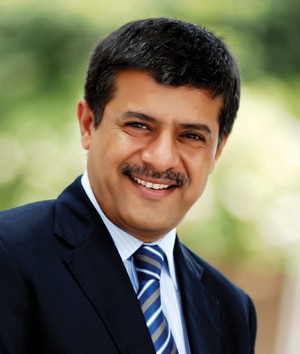
Organisations are increasingly moving to the cloud76 per cent of the respondents in the survey agreed that combining public and private clouds can improve security and agility. However, barriers will need to be overcome to achieve the full potential of cloud computing. Ninety-five per cent of respondents in India report that their CXOs consider IT as a strategic lever to grow their businessnow more than ever before. However, the top three business priorities when implementing new technologies in Indian organisations areto enhance customer experiences (as per 51 per cent of the respondents), automate processes (41 per cent of the respondents), and improve sales and marketing capabilities (38 per cent of the respondents).Seventy-seven per cent of respondents in India agree that their organisations view the increasing role of automation such as software defined storage as critical to business growth.
It was in this context that Diksha P Gupta from Open Source For You spoke to Rajesh Janey, president, India and SAARC, EMC, who revealed how SMAC (social, mobile, analytics and cloud) will change the way IT operates in the country. Excerpts:
Q The trend called SMAC is taking over the IT world. Can you please elaborate on how SMAC is affecting the new style of IT?
New style of IT is really not the term we would like to use. We use the term that IDC uses, which is the third platform. The first platform was typically when the mainframe was in the data centre and you connected terminals to it. The second platform was client-server computing, where the data centre minicomputers connected across the globe over LANs, WANs and desktops. Given the proliferation of mobile devices, the need to remain connected for 24 hours, and the fact that there are billions of applications and millions of users, a new IT infrastructure is now evolving. Thats what IDC calls the third platform, and we use that terminology for technology that is always available, always on, provides access any time, anywhere, on demand, and to any kind of application.
Q So, what are the key components of this third platform, according to you?
The components are the same, including the server, storage and the network, but deployed in a different fashion. This platform is virtualised, automated and standardised, unlike the silo kind of infrastructure. Earlier, when you were implementing an HR or an ERP system, it came with a server, storage, a network, and the system was deployed for that specific application or set of applications. Now it is different. Today, a cloud becomes a pool of resources, which includes a pooled server, pooled storage and pooled network, which are in the form of software. This is a software defined data centre and you run apps, or interact with the apps on top of it. So you virtualise, automate and standardise it, and its like everything is in a pool.
Q How are Indian enterprises reacting to SMAC?
The cloud and the hybrid cloud are being discussed a lot these days. Everyone is talking of virtualisation, moving to a private cloud, IT-as-a-service, moving to a public cloud or exploring a combination of the public and private cloud. Analytics is being adopted by a lot by banks, the telecom sector, et al. Mobility is increasing and its now a given. Every organisation today is mobile-enabled in one way or the other. I cannot think of any organisation that does not allow email access or access to any other corporate apps on the mobile. The last component is social. Quite a few organisations are already adopting the trend called social. If I were to rank them, mobility is now hygiene, the cloud has the highest adoption, followed by analytics and social (in that order). The moment you are social, you need to have analytics. So both go hand in hand. The SMAC trend is here to stay and those who do not adopt it, might be left behind in the race.
Q But the cloud definitely comes with certain fears for CIOs. They still watch each step when they venture into the world of the cloud. Do you agree?
I think things have changed. When it all started about four to five years ago, it was certainly a grey area. We have been doing our bit to demystify the cloud. Its not fear, per se. The cloud is IT-as-a-service, on demand. So when it comes to expectations from the cloud, you want it to run like any other site outside your IT scope. A CIO has to deliver to that expectation. So CIOs are building the infrastructure, which is giving users the experience that they want. There is no fear any more. Most progressive organisations are building or have built a cloud-like infrastructure, which is a combination of the private and public. The cloud has certainly brought about a new way of looking at IT.
Q In your survey, it was highlighted that the spending on IT is moving out of the hands of the IT department in an organisation. Please elaborate on this point.
If a business-oriented company approaches its IT department and asks it to fulfil a requirement, but is told that it will take six months to deliver what they want, the management will approach a service provider to deliver what it wants, within the time frame. The management would be happy to pay a service provider for doing the task. In this case, the decision to outsource is taken by the management and not the IT head. When the management takes such decisions, it is shadow IT. So one is doing an IT job, but sans the IT department because it refused or couldnt meet the given requirements. So 31 per cent of the respondents of the survey believed that some of the IT budgets are no longer being controlled by IT heads, and that part of the budget was being spent by people like the chief marketing officer, the chief sales officer, etc.
Q Is shadow IT a threat for the traditional IT set-up or to IT heads?
Not really! What we are observing is that shadow IT is also forcing the IT departments to become the IT service providers. So instead of the IT guys saying that they will take six months for a job, they are now saying that they can bring in a service provider from the outside world and can act as a broker of that service provider for the business guys. They can take the budget and get the job done. So it is not a threat. But, if they dont act as a broker, then it is a threat and the budgets will go away from them. The IT department has to now act as a broker of services or of service providers.
Q So, who is driving this trend of shadow IT?
The demand from businesses is the true driver in this case. IT is becoming a key lever for growth. Businesses need quicker responses now, because there is immense pressure from the customers. It is the customers and the changing business and customer needs that are driving this trend.
Q With this trend of SMAC coming in, do you think that the CIOs face a skills-gap challenge?
Yes, about 76 per cent of the CIOs surveyed by us do feel so. These trends of social, mobile, analytics and cloud have just started, and the skills the IT departments have are suited for todays needs. But they lack skills required for the times when these trends reach another level.
Q How does one bridge this gap?
There are two ways of doing this. One is the skills part, where companies work with colleges and students to train people. We have joined hands with more that 200 colleges in India, where we train students on the cloud and Big Data. We also have a training programme for our customers, during which they can send their people and get them trained on these latest technologies.
The second way is that instead of people-training, which of course is an important aspect, we emphasise the potential to bring in more software tools and automation, so that the resources use tools that are intelligent enough for the job. Thats where the whole notion of a software defined set-up comes in. This should not be taken as replacing human resources with technology. It is, instead, augmenting their skills. Its like using a calculator. Do I know calculations… the answer is yes, but the calculator will help me speed up the calculations, and I should know how and when to use it.









































































